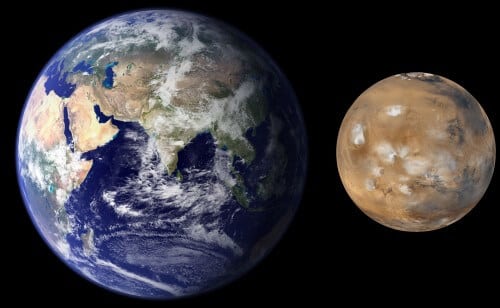Researchers who used new processes identified in models of planet formation, starting from the first stage when they were tiny bodies called pebbles, were able to explain why Mars is much smaller than Earth. The same process also explains the rapid creation of gas giants such as Jupiter and Saturn.

Researchers from the Southwest Science Institute have developed a model of planet formation that explains the differences in size and mass between Earth and Mars.
Image: Mars is much smaller and its mass is only about one-tenth that of Earth. The conventional models of the formation of the solar system succeeded in creating parallels to the Earth and Venus, but also predicted that Mars would be a similar size or even larger than the Earth.
"This numerical simulation was able to create the correct structure of the inner solar system with Earth, Venus and Mars when it is smaller," says Hal Levison, a scientist in the Department of Planetary Sciences who is the principal investigator of a paper published in PNAS.
The fact that the mass of Mars is only one-tenth that of Earth has been a puzzle to theorists studying the solar system. In the standard models of planet formation, bodies of similar sizes form through a process known as growth. Rocks stack on top of other rocks and form mountains, then the mountains accumulate into larger blocks and so on. While a typical growth model makes good parallels for Earth and Venus, they predict that Mars will be similar in size or even larger than Earth. In addition, these models also overestimate the total mass of the asteroid belt.
"Understanding the reasons why Mars is actually smaller than expected is a major problem that has hampered the modeling efforts of the solar system for decades," said Loizon. "We have a solution that stems directly from the planet formation process itself."
New calculations made by Levison and his colleagues tracked the growth and development of the planetary system. They illustrated how the structure of the inner solar system is a natural result of the new mode of planet growth known as Viscously Stirred Pebble Accretion (VSPA). Using VSPA, the dust crystallizes and grows into pebbles - bodies a few centimeters in size. Such bodies clump together through gravity to form objects the size of asteroids. Under the right conditions, these early asteroids can engulf the remaining pebbles, with the aerodynamic drag pushing the pebbles into orbit, where they spin up and merge into a large planetary body over a relatively short period of time.
However, the new models revealed that not all ancient asteroids were in a place where it was possible for them to attract pebbles and grow. For example, objects the size of Ceres (which is about a thousand km in diameter), the largest asteroid in the asteroid belt, will grow faster in the region of Earth's current orbit but will not be able to grow efficiently near the current position of Mars and beyond because the aerodynamic drag will be too weak for the capture process. - pebbles.
"This means that very few pebbles collided to form a larger object in the current position of Mars. This provides a natural explanation for the small size of Mars." says the researcher. "Similarly, much fewer such objects formed in the asteroid belt and this caused the low mass of the belt. The only place to grow effectively was in the current regions of Earth and Venus.”
"These models have huge implications for studying the history of the asteroid belt." says Bill Botke, also from the Southwest Science Institute and a member of the research team. "Previous models included an Earth-mass amount of material in the orbits of Mars and the asteroid belt, so planets could grow there. The new model predicts that the asteroid belt will never contain more mass than that observed in the asteroid belt."
"This model provides the planetary science community with a testable prediction. It will also be able to integrate with the tests of the materials in meteorites, remote sensing and space missions" says Butka.
The research complements research recently published in the journal Nature by Lewison, Kartka and Martin Duncan (of Queen's University) showing how the same pebbles can form the cores of gas giants and explain the structure of the outer solar system. A combination of the two works makes it possible to produce a complete solar system from a single uniform process.

3 תגובות
To be precise, this is an article by the same professor on the same topic in the PNAS journal.
The full article
http://www.pnas.org/content/112/46/14180.full.pdf